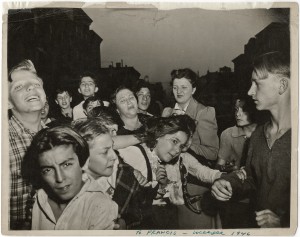The World of Crime Through Two Photographers’ Eyes
Leonard Freed – Concerned Witness
From 1972 to 1979, Freed photographed “life on the beat.” The camaraderie and complexity of his relationships with the New York Police Department resulted in the images from Police Work, published in 1980, currently on display through March 18th at The Museum of the City of New York. Stirring and revelatory, many of the images chosen, pull no punches.
“I stole no pictures,” he said. “What I saw were average people doing a sometimes boring, sometimes corrupting, sometimes dangerous and ugly and unhealthy job.”
Thanks to a recent gift to the museum from his widow Brigitte and curator Sean Corcoran’s detailed presentation; visitors can experience a visual diary which highlights an essential segment of our society, giving the viewer a deeper, more meaningful perspective. The museum, founded in 1923, has remained a lightning rod for the political and cultural climate of the city.
Make no mistake. Freed could portray his share of gritty reality when he chose to do so. But there are images—a policeman frolicking with his kids in a backyard pool, an off-duty patrol woman hanging out on her Honda—that show an unusual warmth and intimacy caught by an obviously caring eye. Some others simply focus on the “business as usual” aspect of the daily grind.
“Freed portrayed the world of the police,” Deidre Fleming, a former lieutenant of the Sixth Precinct (and familiar with the Ninth), told me, “the way they saw it.” (An earlier sampling of photos from The New York Times, before Police Work was published, was entitled “The Ninth Precinct Blues.”)
In one shot, a cop guards an apprehended young man in broad daylight, while an elderly woman, hardly noticing, glares menacingly from the foreground into the camera’s eye. It tells us something about social awareness, or the lack of it, in the photographer’s perspective of the scene.
In another, two policemen, following correct procedure, approach a suspect’s auto. A clipboard with mug shots lays in the foreground of the squad car’s interior. It’s an objective shot that leaves the viewer to fill in the blanks. Yet another, focuses on a suspect’s muscled back in the back seat of the patrol car, handcuffs gleaming in place. It’s a beautiful composition, almost detached in its power from the subject at hand, with the formality of a Paul Strand still life, or later, a Robert Mapplethorpe portrait, with his reverence for the male body. It gives us a rare glimpse of the artistry in Freed’s approach, even under such frenzied circumstances.
Not unlike Weegee, Freed was born to Jewish, working class parents of Eastern European descent, who settled in Brooklyn. He had an early preparation for the experiences he would later share with the NYPD. Though he wanted to be a painter, while photographing in the Netherlands, he finally found his calling. His marches with Martin Luther King and his 1968 book, Black in White America, were a powerful precursor to Police Work. It’s worth noting that Freed wasn’t the only photographer who chose to focus on the “men in blue.” Jill Freedman covered the Ninth Precinct and published Street Cops, creating a powerful, humanistic document.
Fleming, who shared her valuable insights on the exhibit, retired from the Ninth Precinct in 2002. Many of Freed’s images were of members who were once part of her precinct. Not only was the crime rate particularly high in this Lower East Side neighborhood, but a member of the force could be killed in the line of duty.
“They were very disrespected, and felt that nobody really cared. They were just political fodder,” she said, describing the feelings of the police during the turbulent ’70s.
A few prints reveal this chasm between the authority figures and the protestors. A more comprehensive display of such images could have further strengthened this already effective exhibit. Fleming emphasized that there were more political uprisings and prisoners then because the cops were perceived as being “part of the machine” and “racism was so prevalent then.” It, therefore, became impossible for many to look at the police objectively.
According to Fleming, present day portrayal of the police force is a tad bit different, though not without some prejudices still circulating.
“Today the police are part of the social fabric, the social contract, where before they were an evil you didn’t want to think about; there was a real black and white thinking in a country so divided,” she said.
In a foreword to Freed’s book, author Studs Terkel remarked, “Let’s face it, the police make up the buffer zone between the haves and have-nots of our society. Though they are in uniform, you see beneath their skin.”
In a Magnum Photo tribute upon his death in 2006, Freed was quoted as saying, “Ultimately photography is about who you are. It’s the seeking of truth in relation to yourself. And seeking truth becomes a habit.”
If truth is to be had, looking for it in the works of Weegee and Leonard Freed is a good place to begin.
For more information regarding the exhibits visit http://www.icp.org or http://www.mcny.org.


